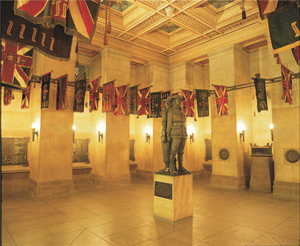DAM strategy pays dividend for Shrine of Remembrace

Digital asset management provides both users and systems administrators organisational control and insight over various media file types and their associated metadata. Without a properly employed digital asset management system, file creation and storage can quickly become a jumbled maze of file system hierarchies, and search and retrieve strategies can be quick to fail.
For museums, there is clear business value in:
significant staff time-savings for file retrieval
alignment of appropriate files to particular end uses
elimination of redundant storage systems
management of image cataloging and storage
creation of an infrastructure for digital preservation
documentation of image provenance
linkage to other core systems that manage digital rights, collection information, or publishing
Melbourne’s landmark Shrine of Remembrance purchased a Cumulus Digital Asset Management (DAM) in early 2010.
The Shrine opened in 1934 to commemorate those who served in the First World War. (1914-18) In 2002-03 a Visitor Centre was built within the foundations of the Shrine. The visitor centre incorporates an education centre (including three classrooms and meeting room), an audio-visual exhibitions space, a retail shop and an administration office.
Since it opened, the Visitor Centre has hosted six temporary exhibitions a year. The images used in these are stored in Cumulus to record copyright details and for ease of retrieval.
Jean McAuslan, Collection Manager, Shrine of Remembrance, said “When we considered using Cumulus we estimated some 3,000 images would need to be withdrawn from our file share drive and were amazed to find 13,000. Most of these are generated by the Shrine as official photography of events and ceremonies, or records of other activities such as exhibitions.”
Of 30 staff at the Shrine, 15 trained users are able to access Cumulus using 5 desktop licenses.
“We expect with the development of new galleries at the Shrine that there will be significantly increased usage of Cumulus and requirements for DAM,” said McAuslan.
Approximately 13,000 assets are arranged in 7 catalogues with 2 designated processing catalogues. The assets are broken into catalogues depending on access restrictions, subject or use. For example the Shrine exhibitions team has a designated catalogue in which it can store assets whilst developing exhibitions. Only the exhibition team has access.
Cumulus is used by all staff for the retrieval of images for use in public programs, schools programs, exhibitions and corporate reports. In addition it is being configured to accommodate the Shrine’s collection records. It is anticipated it will be used for storage of loan agreements and for conservation condition reports on collections items and loans.
The Shrine has developed in-house protocols for file naming and metadata. Generally this consists of a record name that has the catalogues prefix and a unique sequential six-digit number. Compulsory minimum amounts of metadata are required for each asset and it is entered according to the Shrine style guide. The primary focus is on the historical context of the image or its subject rather than the details of a particular camera used for a certain photograph.
Assets are added to the final catalogues via one of two processing catalogues. With different levels of users there are different expectations of comprehensiveness from the people entering the metadata.
The exhibitions and marketing team use a catalogue which gives them full functionality to add and delete assets and a record view set that allows them to see all fields in order to provide comprehensive information.
“Cumulus has provided a great framework for storage and retrieval of images. Images that the Shrine has purchased by the organisation can be quickly identified and easily retrieved, with permissions sought for reuse. One of our highest priorities in implementing this system was the storage of copyright details ensuring that we can meet the requirements of owners,” said McAuslan.
“We are continually developing and refining our use of Cumulus as the needs of the organisation grow and the potential of Cumulus is discovered. The support provided by Databasics and Canto has allowed us to keep the software up to date.
“Our aim is that the output of the metadata will eventually become as flexible and comprehensive as the image retrieval.
“In our organisation the access to textual information is just as important as the access to the image.
